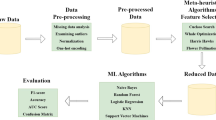Abstract
The free radicals obtained through an H-atom abstraction pathway (RH + •OH → H2O + R•), were used to calculate quantum chemical descriptors for quantitative structure-activity relationship (QSAR) models of rate constants (k OH) for reactions of 161 alkanes with hydroxyl radicals (•OH) in the troposphere. Three quantum chemical descriptors used as the inputs of the support vector machine (SVM) model were selected from 14 quantum chemical descriptors with the genetic algorithm (GA) method together with the multiple linear regressions (MLR) technique. All the descriptors were calculated with the density functional theory (DFT), at the UB3LYP level of theory with 6–31 G(d) basis set. The best prediction results were obtained with the Gaussian radical basis kernel (C = 1, ε = 10−4 and γ = 0.5). The mean root-mean-square (rms) error for the prediction of k OH is 0.314 log units. Our research results indicate that the QSAR model based on GA-MLR and SVM techniques and DFT calculations was accurate and reliable.




Similar content being viewed by others
References
Atkinson, R.: Gas-phase tropospheric chemistry of organic compounds. J. Phys. Chem. Ref. Data 2, 1–246 (1994)
Atkinson, R.: Atmospheric chemistry of VOCs and NOx. Atmos. Environ. 34, 2063–2101 (2000)
Atkinson, R.: Gas-phase tropospheric chemistry of organic compounds: a review. Atmos. Environ. 41, S200–S240 (2007)
Camps-Valls, G., Chalk, A.M., Serrano-Lopez, A.J., Martin-Guerrero, J.D., Sonnhammer, E.L.: Profiled support vector machines for antisense oligonucleotide efficacy prediction. BMC Bioinforma. 5, 135 (2004). doi:10.1186/1471-2105-5-135
Cortes, C., Vapnik, V.: Support-vector networks. Mach. Learn. 20, 273–297 (1995)
De Oliveira, D.B., Gaudio, A.C.: BuildQSAR: a new computer program for QSAR studies. Quant. Struct. Act. Relat. 19, 599–601 (2000)
Erickson, J.A., Mader, M.M., Watson, I.A., Webster, Y.W., Higgs, R.E., Bell, M.A., Vieth, M.: Structure-guided expansion of kinase fragment libraries driven by support vector machine models. BBA Proteins Proteom. 1804, 642–652 (2010)
Fatemi, M.H., Baher, E.: Quantitative structure–property relationship modelling of the degradability rate constant of alkenes by OH radicals in atmosphere. SAR QSAR Environ. Res. 20, 77–90 (2009)
Golbraikh, A., Tropsha, A.: Beware of q2! J. Mol. Graph. Model. 20, 269–276 (2002)
Goodarzi, M., da Cunhab, E.F.F., Freitasb, M.P., Ramalho, T.C.: QSAR and docking studies of novel antileishmanial diaryl sulfides and sulfonamides. Eur. J. Med. Chem. 45, 4879–4889 (2010)
Gramatica, P., Pilutti, P., Papa, E.: A tool for the assessment of VOC degradability by tropospheric oxidants starting from chemical structure. Atmos. Environ. 38, 6167–6175 (2004a)
Gramatica, P., Pilutti, P., Papa, E.: Validated QSAR prediction of OH tropospheric degradation of VOCs: splitting into training-test sets and consensus modeling. J. Chem. Inform. Comput. Sci. 44, 1794–1802 (2004b)
Güsten, H.: Degradation of atmospheric pollutants by tropospheric free radicalreactions. In: Minisci, F. (ed.) Free Dadicals in Biology and Environment. Kluwer Academic Publishers, Dordrecht/Boston/London (1997)
Güsten, H.: Predicting the abiotic degradability of organic pollutants in the troposphere. Chemosphere 38, 1361–1370 (1999)
Karelson, M., Lobanov, V.S., Katritzky, A.R.: Quantum-chemical descriptors in QSAR/QSPR studies. Chem. Rev. 96, 1027–1043 (1996)
Klöpffer, W.: Environmental hazard assessment of chemicals and products. Part VI. Abiotic degradation in the troposphere. Chemosphere 33, 1083–1099 (1996)
Long, X.X., Niu, J.F.: Estimation of gas-phase reaction rate constants of alkylnaphthalenes with chlorine, hydroxyl and nitrate radicals. Chemosphere 67, 2028–2034 (2007)
Michielan, L., Bolcato, C., Federico, S., Cacciari, B., Bacilieri, M., Klotz, K.N., Kachler, S., Pastorin, G., Cardin, R., Sperduti, A., Spalluto, G., Moro, S.: Combining selectivity and affinity predictions using an integrated Support Vector Machine (SVM) approach: an alternative tool to discriminate between the human adenosine A2A and A3 receptor pyrazolo-triazolo-pyrimidine antagonists binding sites. Bioorg. Med. Chem. 17, 5259–5274 (2009)
Öberg, T.: A QSAR for the hydroxyl radical reaction rate constant: validation, domain of application, and prediction. Atmos. Environ. 39, 2189–2200 (2005)
Sabljic, A., Peijnenburg, W.: Modeling lifetime and degradability of organic compounds in air, soil, and water systems (IUPAC Technical Report). Pure Appl. Chem. 73, 1331–1348 (2001)
SPSS: SPSS for Windows, release 11.5.0. SPSS, Chicago (2002)
Tropsha, A., Gramatica, P., Gombar, V.K.: The importance of being earnest: validation is the absolute essentialfor successful application and interpretation of QSPR models. QSAR Comb. Sci. 22, 69–77 (2003)
Vapnik, V.N.: Statistical Learning Theory. Wiley, New York (1998)
Wang, Y.N., Chen, J.W., Li, X.H., Wang, B., Cai, X.Y., Huang, L.P.: Predicting rate constants of hydroxyl radical reactions with organic pollutants: algorithm, validation, applicability domain, and mechanistic interpretation. Atmos. Environ. 43, 1131–1135 (2009)
Yan, C.L., Chen, J.W., Huang, L.P., Ding, G.H., Huang, X.Y.: Linear free energy relationships on rate constants for the gas-phase reactions of hydroxyl radicals with PAHs and PCDD/Fs. Chemosphere 61, 1523–1528 (2005)
Yu, X.L.: Support vector machine-based QSPR for the prediction of glass transition temperatures of polymers. Fiber Polym. 11, 757–766 (2010)
Yu, X.L., Yi, B., Wang, X.Y.: Quantitative structure-property relationships for the reactivity parameters of acrylate monomers. Eur. Polym. J. 44, 3997–4001 (2008a)
Yu, X.L., Liu, W.Q., Liu, F., Wang, X.Y.: DFT-based theoretical QSPR models of Q-e parameters for the prediction of reactivity in free-radical copolymerizations. J. Mol. Model. 14, 1065–1070 (2008b)
Yu, X.L., Yi, B., Yu, W.H., Wang, X.Y.: DFT-based quantum theory QSPR studies of molar heat capacity and molar polarization of vinyl polymers. Chem. Pap. 62, 623–629 (2008c)
Yu, X.L., Yu, W.H., Yi, B., Wang, X.Y.: Prediction of monomer reactivity ratios in radical copolymerization of vinyl monomers. Collect Czech Chem. Commun. 74, 1279–1294 (2009)
Acknowledgments
This work was supported by National Natural Science Foundation of China (Nos. 20972045 and 21172064), Provincial Natural Science Foundation of Hunan (Nos. 10JJ2006 and 10JJ6017) and Scientific Research Fund of Hunan Provincial Education Department (No.11B030).
Author information
Authors and Affiliations
Corresponding authors
Rights and permissions
About this article
Cite this article
Huang, X., Yu, X., Yi, B. et al. Prediction of rate constants for the reactions of alkanes with the hydroxyl radicals. J Atmos Chem 69, 201–213 (2012). https://doi.org/10.1007/s10874-012-9237-2
Received:
Accepted:
Published:
Issue Date:
DOI: https://doi.org/10.1007/s10874-012-9237-2




